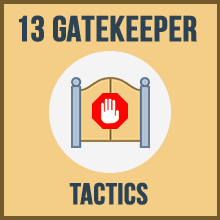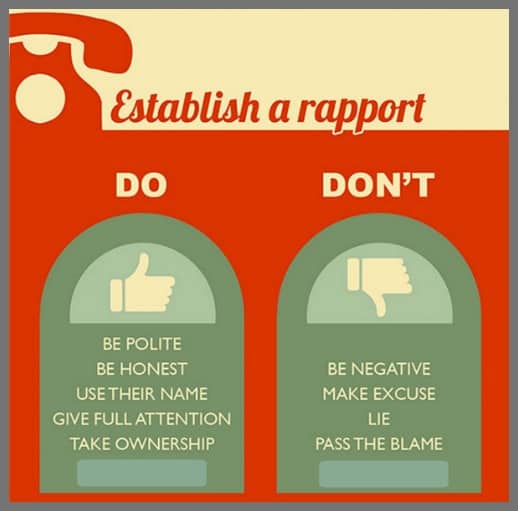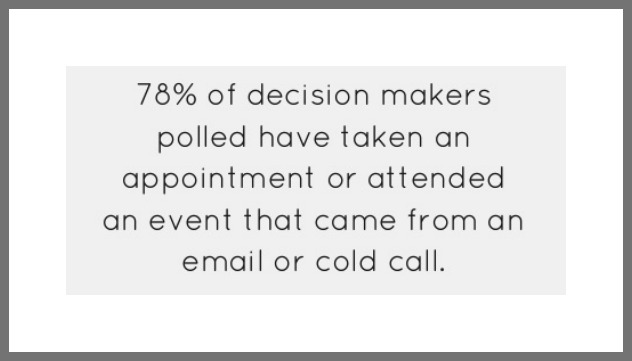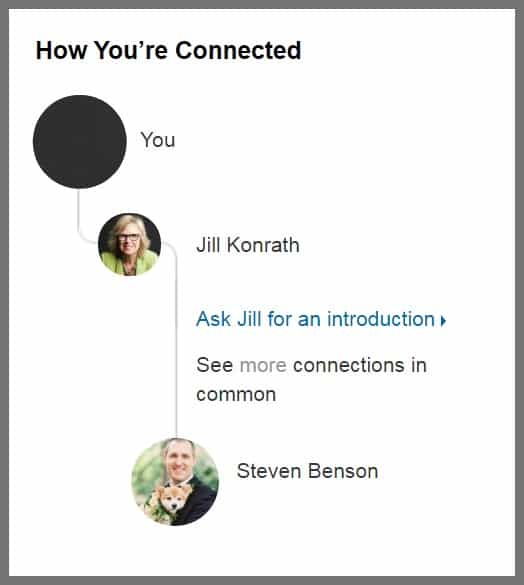
In today’s world, decision-makers are becoming busier and busier. Time is less available than ever before.
Hence, many people direct their calls through gatekeepers such as receptionists. That’s because decision-makers don’t want to waste their precious time taking cold calls.
The gatekeeper often has two main priorities: allowing the right person to speak with their supervisor AND stopping the wrong person from getting in touch.
Therefore, the main aim of the gatekeeper is often to deflect calls and prevent them from going through to the main contact. This creates a challenge for salespeople who need to get in touch with a top executive in order to sell.
That’s why bypassing the gatekeeper is a useful skill for a salesperson to master. Luckily, the toughest gatekeeper is still human. Which means there are a few strategies you could use.
Below are 13 of these strategies that can help you get past the gatekeeper and reach decision-makers.
1. Be conversational
At the end of the day, the gatekeeper has the power. They determine whether or not you speak to the decision-maker. Make friends with them. Be social. The conversation is your key to success. As soon as you find out their name, use it. Building rapport with the gatekeeper is the most important step of this whole process.

(Source: Entrepreneur)
Also keep in mind that emotion influences in a variety of ways. Today’s technology assist you in uncovering new leads and smashing your sales goals. Unfortunately, it costs vast amounts of money to implement. However, the most valuable sales tool remains free – good manners.
2. Be humorous
Humour works in all walks of life. People might not remember what you said, but they always remember how you made them feel. Just beware not to be too controversial with your humor, keep it PG!
Below are four more things to pay attention to during phone conversations. If you follow these, then it becomes easier to convince gatekeepers that you are not just another desperate salesperson.

(Source: Entrepreneur)
Bonus: Former congressman Barney Frank gave some excellent advice on getting what you want and using humor to your advantage.
3. Keep your objective in mind
Your end goal must always be in sight. While it’s important to be polite, build rapport and be charming, your main aim is to get past the gatekeeper and speak to the decision-maker. That should not be overlooked. It’s easy to get lost in conversation, but every good salesperson keeps their eyes on the prize.
4. Social Engagement
Gatekeepers generally don’t run their bosses’ social media profiles. Establish which form of social media they use most often and connect with them through this avenue. Practice your introduction message. or get some cold email templates from experts in your area to help you get past the gatekeeper.
Usually, LinkedIn is the best route to take in a professional capacity. That’s because most decision-makers are active on this site as illustrated by the statistics below.

(Source: Brandon Gaille )
5. Never take a ‘no’ from someone who doesn’t have authority
The gatekeeper has been trained to redirect calls. Their job is to free the decision-maker’s time for what they think are the ‘more important things’. However, as the name suggests, they don’t have the authority to say ‘no’.
Never end the call on a rejection. If the gatekeeper continues their resistance, send an email and schedule a time to call back. Speaking to the gatekeeper is never the end of the process, just the beginning.
6. Call off hours
Catching a prospect by surprise is a great way to get past the gatekeeper. If you’re an early riser, send an email bright and early in the morning. If you’re playing with your phone in bed, send an email late at night.
If the lead contact thinks that you’re a workaholic, there’s a better chance they will give you the time of day and respond. Think outside the box. When would you be most receptive to an annoying sale email?
Take a look at the results of a poll below. It is evident that decision-makers do respond to cold emails or cold calls. But this is more likely to happen when the gatekeeper isn’t around.

7. Use your network
We often know far more people than we think. Reach out to others in your network. Talk to friends. Check for common connections. A warmer contact will more often than not work much better than a cold call or email.
Use all the tools you have available. A popular quote comes to mind, ‘It’s not what you know, it’s who you know’.
On LinkedIn for example, you can easily do this. This works for people who are not yet part of your network. Scroll down their profile and you will see if anyone in your network knows them. You can then ask for an introduction.

8. Ask who’s in charge of the budget
Ideally, you will know the first name of exactly who you should be speaking with. Unfortunately, this isn’t always possible. However, it’s best to make the most out of this situation.
When speaking to the gatekeeper, ask the question, “who’s in charge of the budget?”. It may seem blunt, but once rapport is built with the gatekeeper you should get straight to the bottom line and find out the name of who’s in charge.
This is important for future reference. Also, if the gatekeeper doesn’t let you through at this stage, it will be vital when finding references and other avenues to reach the person in charge.
9. Use the first name of the decision-maker
Asking for someone by their first name is always much more effective. It gives the impression that you know this person and have a right to talk to them. When doing this, be confident and don’t hesitate.
A good example could be as follows, “Hi, it’s Michael Dunphy, is James in?” (His first name + my full name, but no company name — that makes it obvious that he knows you and you should not be denied.)
This is where LinkedIn can help you. By visiting company pages, you can see all those who work there. For example, below is Badger Maps’s company page on LinkedIn. On the right-hand side, you can see a lineup of employee profiles.
You can also use Email Format Checker to get a similar list of all employees in a company that you’re looking up.

Clicking on “see all” opens up a new window. Here, you can quickly discover who the decision-maker is along with some more information about them that can come in handy later on.

10. If you can’t make the sale, help them make the sale
Put yourself in the gatekeepers shoes. Make sure they see the brilliance of what your product or service has to offer. You want them to enthusiastically pass on the message to their boss. This will increase the chances of getting through to the decision-maker. Think of the gatekeeper as the bait and the boss as the great white shark. What’s going to make him/her bite?
11. Ask for help
The gatekeeper is used to taking hundreds of calls on a daily basis. The majority of these are salespeople trying to con and trick them into getting through to a decision-maker. Instead, be honest with the gatekeeper. Ask them for help.
If they were in your position, what would they do? When is the best time to get through to the boss? What mode of communication is the best to get them on? Have a list of questions ready. When you treat them like a normal human being, there is a much higher chance that they will be receptive to you. Honesty may well be the best way to get past the gatekeeper.
12. Keep it snappy
You generally have a thirty-second time limit to impress the gatekeeper. You should limit your pitch to these thirty seconds. Write it down and learn it by heart. This is what you will hit the gatekeeper with when they answer the phone. Since attention spans are drastically decreasing over time, it’s best to keep your pitch as short as possible.

(Source: WebPro News)
As mentioned previously, evaluate your pitch from a gatekeeper’s point of view. If recommending your product or service to their boss will get them brownie points, it’s a win-win situation.
13. End on a high note
When coming off yet another unsuccessful call, it can be hard to mask your true feelings. You’ve been rigorously attempting to get through to the right party and you failed again. No matter how upset you are, never show your displeasure over the phone.
The gatekeeper may be a CEO one day, we don’t know what the future holds. Therefore, always end the call on a high note. If it ends badly there will be a sour taste in the gatekeepers mouth when, and if, they bother to pass the message on to their supervisor.
Conclusion
It’s clear that getting past the gatekeeper and reaching your desired contact is not easy. However, by following these 13 steps you’ll have solid strategies up your sleeves that you can implement.
Whichever route you decide to take, keep in mind that respect and manners win out in the end whenever you’re dealing with other people. You can find further help on this matter through world famous sales trainer Grant Cardone, who has devised some extremely helpful videos to help you out. Virtual Sales has also laid out ten tips to get past the gatekeeper here.
I hope you found this information helpful and thanks for reading! If you have something to add that may improve the helpfulness of this information, I’d love to hear from you. Whatever the case, leave your thoughts in the comment box below and I will get back to you.
About the Author
Aaron Conroy is a Sales Development Associate and Content Writer at Badger Maps, the #1 Sales App in the Apple App Store which helps field salespeople be more successful. Badger shows salespeople their customers and leads on a map and connects to their calendar to build daily routes.

Leave a Reply